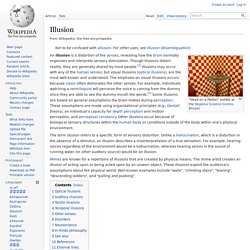

A Mathmatician's Lament. English* Bouba/kiki Effect. This picture is used as a test to demonstrate that people may not attach sounds to shapes arbitrarily: American college undergraduates and Tamil speakers in India called the shape on the left "kiki" and the one on the right "bouba".

The bouba/kiki effect is a non-arbitrary mapping between speech sounds and the visual shape of objects. This effect was first observed by German-American psychologist Wolfgang Köhler in 1929.[1] In psychological experiments, first conducted on the island of Tenerife (in which the primary language is Spanish), Köhler showed forms similar to those shown at the right and asked participants which shape was called "takete" and which was called "baluba" ("maluma" in the 1947 version). Although not explicitly stated, Köhler implies that there was a strong preference to pair the jagged shape with "takete" and the rounded shape with "baluba".[2] In 2001, Vilayanur S. More recently research indicated that the effect may be a case of ideasthesia.[5] QualiaSoup. It *could* just be coincidence.
The Scale of the Universe. Illusion. An illusion is a distortion of the senses, revealing how the brain normally organizes and interprets sensory stimulation.

Though illusions distort reality, they are generally shared by most people.[1] Illusions may occur with any of the human senses, but visual illusions (optical illusions), are the most well-known and understood. The emphasis on visual illusions occurs because vision often dominates the other senses. For example, individuals watching a ventriloquist will perceive the voice is coming from the dummy since they are able to see the dummy mouth the words.[2] Some illusions are based on general assumptions the brain makes during perception. These assumptions are made using organizational principles (e.g., Gestalt theory), an individual's capacity for depth perception and motion perception, and perceptual constancy.
Other illusions occur because of biological sensory structures within the human body or conditions outside of the body within one’s physical environment. Steven Pinker-Culture & Evolution. Shady Optical Illusion. Feynman 'Fun to Imagine' 4: Magnets (and 'Why?' questions...) McGurk effect. Background[edit] The McGurk effect is sometimes called the McGurk-MacDonald effect.

It was first described in 1976 in a paper by Murr McGurk and John MacDonald titled "Hearing Lips and Seeing Voices".[5] This effect was discovered by accident when McGurk and his research assistant, MacDonald, asked a technician to dub a video with a different phoneme from the one spoken while conducting a study on how infants perceive language at different developmental stages. When the video was played back, both researchers heard a third phoneme rather than the one spoken or mouthed in the video.[6] This effect may be experienced when a video of one phoneme's production is dubbed with a sound-recording of a different phoneme being spoken. Often, the perceived phoneme is a third, intermediate phoneme. It has also been examined in relation to witness testimony. Internal factors[edit] Damage[edit] Disorders[edit] Dyslexia[edit] Specific language impairment[edit] Autism spectrum disorders[edit] Aphasia[edit]
TheraminTrees's Channel#p/a/u/0/TrNIuFrso8I.